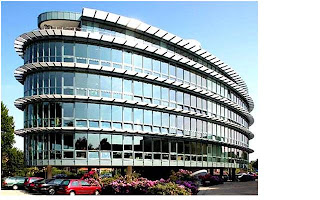 Flat roof
Flat roof
From Wikipedia, the free encyclopedia
Jump to:
navigation,
searchA flat roof is a type of covering of a
building. In contrast to the sloped form of a
roof, a flat roof is horizontal or nearly horizontal. Materials that cover flat roofs should allow the
water to run off freely from a very slight inclination.
Traditionally flat roofs would use a
tar and
gravel based surface which, as long as there was no pooling of water, was sufficient to prevent penetration. However, these surfaces would tend to fail in colder
climates, where
ice dams and the like could block the flow of water. Similarly, they tend to be sensitive to sagging of the roof reversing the subtle grading of the surface.
Modern flat roofs tend to use a continuous
membrane covering which can better resist pools of standing water. These membranes are applied as a continuous sheet where possible, though sealants and
adhesives are available to allow for bonding multiple sheets and dealing with structures penetrating the roof surface. Far more expensive flat roof options include sealed
metal roofs using
copper or
tin. These are
soldered interlocking systems of metal panels.
Modernist architecture often viewed the flat roof as a living area.
Le Corbusier's theoretical works, particularly Vers une Architecture, and the influential
Villa Savoye and
Unité d'Habitation prominently feature rooftop
terraces.
Flat roofs tend to be sensitive to human traffic. Anything which produces a crack or puncture in the surface can quite readily lead to leaks. It is thus not generally advisable to use a flat roof as a living area unless steps are taken to protect the roofing membrane from those using the area, for example, by building a wooden
deck over the surface or using paving stones or similar materials to protect the roof membrane.
One of the more interesting (re)emerging methods of protecting the roofing membrane is to use a layer of
topsoil and
grasses. Care should be taken not to plant anything the
roots of which will penetrate the membrane surface. The
green roof interestingly enough, tends to trap moisture on the roof, but keeps it up in the soil and plants, rather than having it pool down on the membrane surface.
[
edit]
Maintenance and Assessment of Flat Roofs
The life expectancy of a flat roof can be proportional to the
maintenance done on it. Some assessors use 10 years as an average life cycle, although this is dependent on the type of flat roof system in place. Some old
tar and
gravel roofers quietly acknowledge that unless a roof has been neglected for too long and there are many problems in many areas, a BUR (a built up roof of tar, paper and gravel) will last indefinitely. There are BUR systems in place dating to the early 1900's.
Maintenance includes getting rid of ponding water, typically within 48-72 hours. This is accomplished by adding roof drains or scuppers for a pond at an edge or automatic
siphons for ponds in the center of roofs. An automatic siphon can be created with an inverted ring shaped
sprinkler, a
garden hose, a
wet/dry vacuum, a
check valve installed in the vacuum, and a digital timer. The timer runs two or three times a day for a minute or two to start water in the hose. The timer then turns off the vacuum, but the weight of water in the hose continues the siphon and soon opens the check valve in the vacuum.
Annual maintenance means inspecting protrusions like vents and edge cant strips. The sharp bends at such places can open up and need to be sealed with plastic cement,
mesh and a small masons'
trowel. Additionally, repairs to lap seams in base
flashings should be made. Base flashings lead to approximately 90% of all roof leaks and failure. Another important maintenance item, often neglected, is to simply keep the roof drains free of debris. A clogged roof drain will cause water to pond, leading to increased "dead load" weight on building that may not be
engineered to accommodate that weight. Additionally, ponding water on a roof will can freeze. Often, water will find it's way into a flashing seam. Water will also freeze into these seams.
Maintenance also includes keeping the
tar paper covered with gravel, an older method, currently being replaced with
bituminous roofing membranes and the like, which must be 'glued' in place so
wind and waves do not move it causing scouring and more bare spots. The
glue can be any exterior grade glue like driveway coating.
Maintenance also includes fixing
blisters (delaminations) or creases that may not yet be leaking but will leak over time. They may need experienced help as they require scraping away the gravel on a cool morning when the tar is brittle, cutting open, and covering with plastic cement or
mastic and mesh. Any moisture trapped in a blister has to be dried before being repaired.
Infrared photography is being used to take pictures of roofs at night to find trouble spots. When the roof is cooling, wet spots not visible to the naked eye, continue to emit heat.
Camcorders with night photography do not appear to be in the right part of the infrared spectrum to capture the shadow of such heat.
Retrieved from "
http://en.wikipedia.org/wiki/Flat_roof"
 CURTAIN WALL
CURTAIN WALL (EXAMPLE OF BUILDING USED CURTAIN WALL)
(EXAMPLE OF BUILDING USED CURTAIN WALL)















